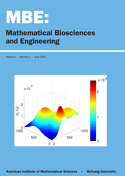Ver ítem
- xmlui.general.dspace_homeCentros Regionales y EEAsCentro Regional Patagonia NorteEEA BarilocheArtículos científicosxmlui.ArtifactBrowser.ItemViewer.trail
- Inicio
- Centros Regionales y EEAs
- Centro Regional Patagonia Norte
- EEA Bariloche
- Artículos científicos
- Ver ítem
Life history traits of Sirex noctilio F. (Hymenoptera: Siricidae) can explain outbreaks independently of environmental factors
Resumen
La avispa Sirex noctilio es una plaga importante de las plantaciones de pino en todo el mundo. Económicamente daño significativo se limita sin embargo a brote poblaciones. Para entender lo que determina la dinámica de los brotes en esta especie, hemos desarrollado un modelo basado individuo para una población de avispas en desarrollo
dentro de una plantación de pinos. Se demuestra que los brotes pueden ser el resultado de la historia de vida del insecto.
[ver mas...]
La avispa Sirex noctilio es una plaga importante de las plantaciones de pino en todo el mundo. Económicamente daño significativo se limita sin embargo a brote poblaciones. Para entender lo que determina la dinámica de los brotes en esta especie, hemos desarrollado un modelo basado individuo para una población de avispas en desarrollo
dentro de una plantación de pinos. Se demuestra que los brotes pueden ser el resultado de la historia de vida del insecto. espec camente se muestra que la dispersión limitada puede no sólo aumentar la persistencia de la población, sino también crear las condiciones para la dinámica eruptiva.
[Cerrar]
The woodwasp Sirex noctilio is a major pest of pine plantations worldwide. Economically significant damage is however limited to outbreak populations. To understand what determines outbreaks dynamics in this species, we developed an individual based model for a wasp population developing within a pine plantation. We show that outbreaks may be the result of the insect's life history. Specifically we show that limited dispersal may not only increase
[ver mas...]
The woodwasp Sirex noctilio is a major pest of pine plantations worldwide. Economically significant damage is however limited to outbreak populations. To understand what determines outbreaks dynamics in this species, we developed an individual based model for a wasp population developing within a pine plantation. We show that outbreaks may be the result of the insect's life history. Specifically we show that limited dispersal may not only increase population persistence but also create the conditions for eruptive dynamics. When the probability of long distance dispersal is greater than zero, but relatively small (PLDD= 0.1) large outbreaks are the norm, with all of the suitable trees dead at the end of the simulation. For PLDD= 0 (only local dispersal allowed) outbreaks are smaller in size, and in some cases not well defined and spread over longer periods. For PLDD= 1 (only long distance dispersal allowed), the frequency of local population extinction (without outbreaks) increases significantly. Aggregated attacks may induce physiological changes in the trees which could allow other wasps to detect them. These changes may in turn trigger an outbreak. In contrast, healthy, vigorous trees are not suitable for wasp oviposition. In our model the density of suitable trees (healthy trees but yet suitable for oviposition) are a key factor determining population persistence before outbreaks. From an applied perspective, our results emphasize the importance of adequate plantation management in preventing woodwasp infestation
[Cerrar]

Fuente
Mathematical biosciences and engineering 10 (5/6) : 1265-1279. (October/December 2013)
Fecha
2013-12
ISSN
1547-1063 (Print)
1551-0018 (Online)
1551-0018 (Online)
Formato
pdf
Tipo de documento
article
Palabras Claves
Derechos de acceso
Abierto
 Excepto donde se diga explicitamente, este item se publica bajo la siguiente descripción: Creative Commons Attribution-NonCommercial-ShareAlike 2.5 Unported (CC BY-NC-SA 2.5)
Excepto donde se diga explicitamente, este item se publica bajo la siguiente descripción: Creative Commons Attribution-NonCommercial-ShareAlike 2.5 Unported (CC BY-NC-SA 2.5)


